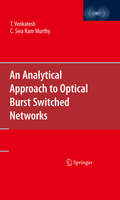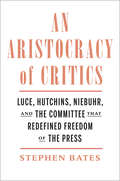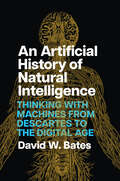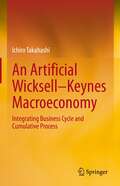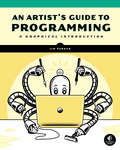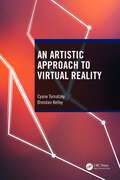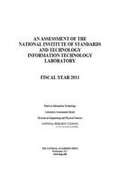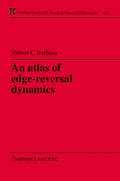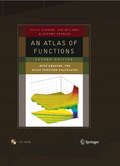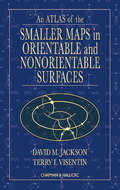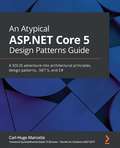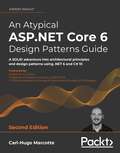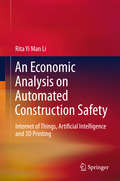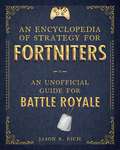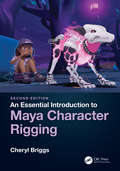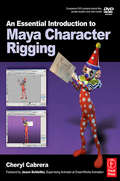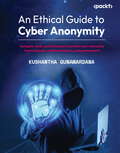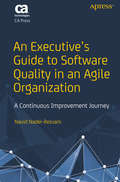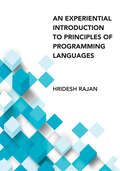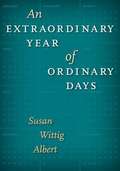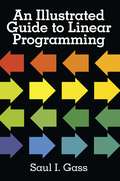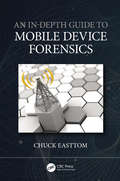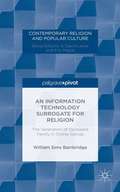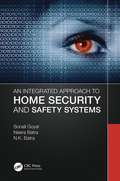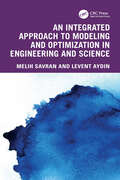- Table View
- List View
An Analytical Approach to Optical Burst Switched Networks
by C. Siva Murthy T. VenkateshThis book presents the state of the art results on modeling and analysis of OBS networks. It provides researchers with new directions for future research and helps them gain a better understanding of modeling OBS networks. This book classifies all the literature on modeling and analysis of OBS networks and serves as a thought provoking material for the researchers working on the analysis of high-speed networks. The scope of this book however is not limited to OBS networks alone but extends to high-speed communication networks with limited or no buffers.
An Aristocracy of Critics: Luce, Hutchins, Niebuhr, and the Committee That Redefined Freedom of the Press
by Stephen BatesThe story behind the 1940s Commission on Freedom of the Press—groundbreaking then, timelier than ever now"A well-constructed, timely study, clearly relevant to current debates."—Kirkus, starred review In 1943, Time Inc. editor-in-chief Henry R. Luce sponsored the greatest collaboration of intellectuals in the twentieth century. He and University of Chicago president Robert Maynard Hutchins summoned the theologian Reinhold Niebuhr, the Pulitzer-winning poet Archibald MacLeish, and ten other preeminent thinkers to join the Commission on Freedom of the Press. They spent three years wrestling with subjects that are as pertinent as ever: partisan media and distorted news, activists who silence rather than rebut their opponents, conspiracy theories spread by shadowy groups, and the survivability of American democracy in a post-truth age. The report that emerged, A Free and Responsible Press, is a classic, but many of the commission&’s sharpest insights never made it into print. Journalist and First Amendment scholar Stephen Bates reveals how these towering intellects debated some of the most vital questions of their time—and reached conclusions urgently relevant today.
An Artificial History of Natural Intelligence: Thinking with Machines from Descartes to the Digital Age
by David W. BatesA new history of human intelligence that argues that humans know themselves by knowing their machines. We imagine that we are both in control of and controlled by our bodies—autonomous and yet automatic. This entanglement, according to David W. Bates, emerged in the seventeenth century when humans first built and compared themselves with machines. Reading varied thinkers from Descartes to Kant to Turing, Bates reveals how time and time again technological developments offered new ways to imagine how the body’s automaticity worked alongside the mind’s autonomy. Tracing these evolving lines of thought, An Artificial History of Natural Intelligence offers a new theorization of the human as a being that is dependent on technology and produces itself as an artificial automaton without a natural, outside origin.
An Artificial Wicksell—Keynes Macroeconomy: Integrating Business Cycle and Cumulative Process
by Ichiro TakahashiThis book presents an agent-based macroeconomic model developed on the Keynesian principle of effective demand and the Wicksellian theory of cumulative process. The main purpose of the book is to demystify inherent forces that revive an economy from a long-run downturn. The model has three types of bounded-rational agents: firm, household, and bank. To highlight the autonomous revival mechanisms, the model is assumed to be completely closed and free from any external influences such as changes in management of aggregate demand or supply/demand shocks. The key finding of the book is that diversity of firms is a crucial element in reviving investment activities. While a production sector is represented by a single firm in a conventional model, this model has introduced a large number of heterogeneous firms that confront diverse constraints both at the firm and aggregate levels. The behaviours of these firms may vary despite being exposed to the same aggregate environment. For example, economic downturns usually precipitate a fall in real wages as a response to decreased aggregate demand. Most firms reduce their employment focusing on the reduction in aggregate demand. However, some firms identify a reduction in real wage as a sign of improving profitability hence they may expand employment. This could result in an increased aggregate demand and benefit other firms with further employment. It could even reverse the trend to an upslope, thereby ultimately achieving full of near full employment. This book details further on: (1) the rigidity of prices and wages in a stable economy (2) the fundamental factors to establish a robust and high-performing economy, with the focus on the importance of a stable and equitable macroeconomic environment.
An Artist's Guide to Programming: A Graphical Introduction
by Jim ParkerLearn to program with visual examples. Programs increase in complexity as you progress — from drawing a circle to 3D graphics, animations, and simulations.A Graphical Introduction to Programming teaches computer programming with the aid of 100 example programs, each of which integrates graphical or sound output. The Processing-language-based examples range from drawing a circle and animating bouncing balls to 3D graphics, audio visualization, and interactive games. Readers learn core programming concepts like conditions, loops, arrays, strings and functions, as well as how to use Processing to draw lines, shapes, and 3D objects. They&’ll learn key computer graphics concepts like manipulating images, animating text, mapping textures onto objects, and working with video. Advanced examples include sound effects and audio visualization, network communication, 3D geometry and animation, simulations of snow and smoke, predator-prey populations, and interactive games.
An Artistic Approach to Virtual Reality
by Cyane Tornatzky Brendan KelleyA special quality about the medium of virtual reality is its immersive nature, allowing users to disengage from the physical world around them in order to fully interact with a digital environment. An Artistic Approach to Virtual Reality traces the lineage of artist/technologists who have worked with virtual reality in its infancy to the interactive virtual work of contemporary artists such as Laurie Anderson. Interlaced within a survey of artists whose works fit in the boundary of the interactive virtual medium, this book teases out what qualifies as interactive virtual artworks. The authors discuss the theories behind basic mechanics required to enter the virtual reality space and investigate theories around visual and embodied conceptual space. Key Features: · Explores theoretical and practical aspects of using virtual reality for artistic practice. · Includes examples and discussion of virtual reality artworks from award-winning artists. · Discusses topics relevant to virtual reality that are pertinent and persist throughout hardware and software changes. · Provides historical and contemporary discussion of virtual reality artistic works.
An Assessment of the National Institute of Standards and Technology Information Technology Laboratory: Fiscal Year 2011
by Panel on Information TechnologySince 1959, the National Research Council (NRC), at the request of the National Institute of Standards and Technology (NIST), has annually assembled panels of experts to assess the quality and effectiveness of the NIST measurements and standards laboratories. In 2011, the NRC evaluated three of the six NIST laboratories: the Center for Nanoscale Science and Technology (CNST), the NIST Center for Neutron Research (NCNR) and the Information Technology Laboratory (ITL). Each of these was addressed individually by a separate panel of experts; this report assesses ITL.
An Atlas of Edge-Reversal Dynamics (Chapman & Hall/CRC Research Notes in Mathematics Series)
by V.C. BarbosaThis important resource offers the first in-depth account of the graph dynamics system SER (Scheduling by Edge Reversal),. In Part 1: Edge-Reversal Dynamics, the author discusses the main applications and properties of SER, provides data from statistics and correlations computed over several graph classes, and gives an overview of the algorithmic aspects of the construction of the catalogue. Part 2: The Atlas comprises the atlas proper-a catalogue of graphical representations of all basins of attraction generated by the SER mechanism for all graphs in selected classes.
An Atlas of Functions: with Equator, the Atlas Function Calculator
by Keith B. Oldham Jerome Spanier Jan MylandThis second edition of An Atlas of Functions, with Equator, the Atlas Function Calculator, provides comprehensive information on several hundred functions or function families, of interest to all those scientists, engineers and mathematicians who are concerned with the quantitative aspects of their field. Beginning with simple integer-valued functions, the book progresses to polynomials, exponential, trigonometric, Bessel, and hypergeometric functions, as well as many more. The 65 chapters are arranged roughly in order of increasing complexity, mathematical sophistication being kept to a minimum while utility is stressed throughout. In addition to providing definitions and simple properties for every function, each chapter catalogs more complex interrelationships as well as the derivatives, integrals, Laplace transforms and other characteristics of the function. Numerous color figures in 2 or 3 dimensions depict their shape and qualitative features and flesh out the reader's familiarity with the functions. In many instances, the chapter concludes with a concise exposition on a topic in applied mathematics associated with the particular function or function family. Features that make the Atlas an invaluable reference tool, yet simple to use, include: full coverage of those functions--elementary and "special"--that meet everyday needsa standardized chapter format, making it easy to locate needed information on such aspects as: nomenclature, general behavior, definitions, intrarelationships, expansions, approximations, limits, and response to operations of the calculusextensive cross-referencing and comprehensive indexing, with useful appendicesthe inclusion of innovative software--Equator, the Atlas Function Calculatorthe inclusion of new material dealing with interesting applications of many of the function families, building upon the favorable responses to similar material in the first edition.
An Atlas of the Smaller Maps in Orientable and Nonorientable Surfaces (Discrete Mathematics and Its Applications)
by David Jackson Terry I. VisentinMaps are beguilingly simple structures with deep and ubiquitous properties. They arise in an essential way in many areas of mathematics and mathematical physics, but require considerable time and computational effort to generate. Few collected drawings are available for reference, and little has been written, in book form, about their enumerative a
An Atypical ASP.NET Core 5 Design Patterns Guide: A SOLID adventure into architectural principles, design patterns, .NET 5, and C#
by Carl-Hugo Marcotte Abdelhamid ZebdiA .NET developer's guide to crafting robust, maintainable, and flexible web apps by leveraging C# 9 and .NET 5 features and component-scale and application-scale design patternsKey FeaturesApply software design patterns effectively, starting small and progressing to cloud-scaleDiscover modern application architectures such as vertical slice, clean architecture, and event-driven microservicesExplore ASP.NET design patterns, from options to full-stack web development using BlazorBook DescriptionDesign patterns are a set of solutions to many of the common problems occurring in software development. Knowledge of these design patterns helps developers and professionals to craft software solutions of any scale. ASP.NET Core 5 Design Patterns starts by exploring basic design patterns, architectural principles, dependency injection, and other ASP.NET Core mechanisms. You'll explore the component scale as you discover patterns oriented toward small chunks of the software, and then move to application-scale patterns and techniques to understand higher-level patterns and how to structure the application as a whole. The book covers a range of significant GoF (Gangs of Four) design patterns such as strategy, singleton, decorator, facade, and composite. The chapters are organized based on scale and topics, allowing you to start small and build on a strong base, the same way that you would develop a program. With the help of use cases, the book will show you how to combine design patterns to display alternate usage and help you feel comfortable working with a variety of design patterns. Finally, you'll advance to the client side to connect the dots and make ASP.NET Core a viable full-stack alternative. By the end of the book, you'll be able to mix and match design patterns and have learned how to think about architecture and how it works.What you will learnApply the SOLID principles for building flexible and maintainable softwareGet to grips with .NET 5 dependency injectionWork with GoF design patterns such as strategy, decorator, and compositeExplore the MVC patterns for designing web APIs and web applications using RazorDiscover layering techniques and tenets of clean architectureBecome familiar with CQRS and vertical slice architecture as an alternative to layeringUnderstand microservices, what they are, and what they are notBuild ASP.NET UI from server-side to client-side BlazorWho this book is forThis design patterns book is for intermediate-level software and web developers with some knowledge of .NET who want to write flexible, maintainable, and robust code for building scalable web applications. Knowledge of C# programming and an understanding of web concepts like HTTP is necessary.
An Atypical ASP.NET Core 6 Design Patterns Guide: A SOLID adventure into architectural principles and design patterns using .NET 6 and C# 10, 2nd Edition
by Carl-Hugo Marcotte Abdelhamid ZebdiThe professional developer's essential guide to building robust, maintainable, and flexible web apps by leveraging C# 10 and .NET 6 features and component- and application-scale design patternsKey FeaturesApply the SOLID architectural principles and software design patterns effectively with a focus on dependency injectionDiscover modern application architectures such as vertical slice, clean architecture, and event-driven microservicesExplore full-stack ASP.NET Core with an overview of BlazorBook DescriptionAn Atypical ASP.NET Core 6 Design Patterns Guide, Second Edition approaches programming like playing with LEGO®: snapping small pieces together to create something beautiful. Thoroughly updated for ASP.NET Core 6, with further coverage of microservices patterns, data contracts, and event-driven architecture, this book gives you the tools to build and glue reliable components together to improve your programmatic masterpieces.The chapters are organized based on scale and topic, allowing you to start small and build on a strong base, the same way that you would develop a program. You will begin by exploring basic design patterns, SOLID architectural principles, dependency injection, and other ASP.NET Core 6 mechanisms. You will explore component-scale patterns, and then move to higher level application-scale patterns and techniques to better structure your applications. Finally, you'll advance to the client side to connect the dots with tools like Blazor and make ASP.NET Core a viable full-stack web development framework.You will supplement your learning with practical use cases and best practices, exploring a range of significant Gang of Four (GoF) design patterns along the way. By the end of the book, you will be comfortable combining and implementing patterns in different ways, and crafting software solutions of any scale.What you will learnApply the SOLID principles for building flexible and maintainable softwareGet to grasp .NET dependency InjectionWork with GoF design patterns such as strategy, decorator, facade, and compositeExplore the MVC patterns for designing web APIs and web applications using RazorDiscover layering techniques and tenets of clean architectureBecome familiar with CQRS and vertical slice architecture as an alternate to layeringUnderstand microservices and when they can benefit your applicationsBuild an ASP.NET user interfaces from server-side to client-side BlazorWho this book is forThe book is intended for intermediate software and web developers with an understanding of .NET who want to write flexible, maintainable, and robust code for building scalable web applications. Knowledge of C# programming and an understanding of web concepts like HTTP is necessary.
An Economic Analysis on Automated Construction Safety
by Rita Yi LiThis book addresses information technologies recently applied in the field of construction safety. Combining case studies, literature reviews and interviews to study the issue, it presents cutting-edge applications of various information technologies (ITs) in construction in different parts of the world, together with a wealth of figures, tables and examples. Though primarily intended for researchers and experts in the field, the book will also benefit graduate students.
An Encyclopedia of Strategy for Fortniters: An Unofficial Guide for Battle Royale (Encyclopedia for Fortniters #1)
by Jason R. RichThe Ultimate Unofficial Encyclopedia for Fortniters is a full-color, easy-to-read, unofficial reference tool that explains—from “A” to “Z”—everything players need to know in order to consistently win matches and successfully control their characters. <P><P>The Ultimate Unofficial Encyclopedia for Fortniters provides a comprehensive overview of the game—making it easier for first-time players to quickly get acclimated with the game—while, at the same time, it introduces more experienced players to countless advanced tips and strategies that will allow them to quickly improve their skills and survival rates. The tips and strategies included are related to safe exploration, creative building, offensive and defensive fighting techniques, and cunning survival skills. <P><P>Each of the more than one hundred topics covered within The Ultimate Unofficial Encyclopedia for Fortniters includes a detailed description, full-color screenshots, and appropriate tips and strategies that apply to the current and future versions of the game. This book is a must-read guide and information-packed resource for every Fortnite: Battle Royale player.
An Essential Introduction to Maya Character Rigging
by Cheryl BriggsWhile some rigging books focus too much on the theory of rigging and provide little instruction, others do the exact opposite and offer no reasoning behind the button-pushing. An Essential Introduction to Maya Character Rigging, 2nd Edition, however, offers a perfect balance. Cheryl Briggs’ text is built for the classroom, with step-by-step tutorials that guide the reader through the rigging process. With vibrant screenshots and a plethora of helpful tips, this book provides a strong foundation in character rigging for anyone who wants to pursue 3D animation or more advanced rigging topics. Features Provides readers with fundamental techniques to give them a firm grasp on Maya character rigging. Thorough step-by-step tutorials, which provides instruction on how to create biped, quadruped, and prop rigs. Continuous updates and further support can be located at www.cherylcreates.com Cheryl Briggs (formerly Cabrera) is an award-winning animated short film director. She has advised and guided aspiring animators, game artists, and visual effects artists for 20 years. Since 2009, Cheryl has taught all aspects of production in the Character Animation specialization in the School of Visual Arts and Design at the University of Central Florida. She also taught as Professor of Animation at the Savannah College of Art and Design from 2001 to 2009. Cheryl is currently on the Board of Directors for the Animation Hall of Fame. She also is a member of the Special Interest Group on Computer Graphics and Interactive Techniques (SIGGRAPH), the International Animated Film Society (ASIFA-Hollywood), Women in Animation, Women in Film and Television, and the Society for Animation Studies. Cheryl is also an Autodesk Certified Professional and an Autodesk Certified Instructor in Maya. She is the author of An Essential Introduction to Maya Character Rigging (Focal Press, 2008), Reel Success: Creating Demo Reels and Animation Portfolios (Focal Press, 2013), and Animating Short Stories: Narrative Techniques and Visual Design (Bloomsbury Academic, 2019). Cheryl holds a B.A. and M.Ed. in Education and an M.F.A. in Computer Art with a specialization in 3D Animation. She is a digital artist and animator that blends the lines between digital imagery and the traditional painting medium. She has participated is numerous group and solo exhibitions in the United States and her work is featured in several private collections. Her award-winning students have been featured in animation festivals worldwide, and many have gone on to work within the entertainment industry.
An Essential Introduction to Maya Character Rigging with DVD
by Cheryl CabreraDiscover the concepts and techniques required to rig engaging CG character models with Maya in this unique book and DVD package. The stunning color images show just what you can achieve, and the detailed step-by-step tutorials show exactly how to achieve them. Every technique and tip is backed up with practical tutorials, using the models, student
An Ethical Guide to Cyber Anonymity: Concepts, tools, and techniques to protect your anonymity from criminals, unethical hackers, and governments
by Kushantha GunawardanaDive into privacy, security, and online anonymity to safeguard your identityKey FeaturesLeverage anonymity to completely disappear from the public viewBe a ghost on the web, use the web without leaving a trace, and master the art of invisibilityBecome proactive to safeguard your privacy while using the webBook DescriptionAs the world becomes more connected through the web, new data collection innovations have opened up more ways to compromise privacy. Your actions on the web are being tracked, information is being stored, and your identity could be stolen. However, there are ways to use the web without risking your privacy. This book will take you on a journey to become invisible and anonymous while using the web.You will start the book by understanding what anonymity is and why it is important. After understanding the objective of cyber anonymity, you will learn to maintain anonymity and perform tasks without disclosing your information. Then, you'll learn how to configure tools and understand the architectural components of cybereconomy. Finally, you will learn to be safe during intentional and unintentional internet access by taking relevant precautions.By the end of this book, you will be able to work with the internet and internet-connected devices safely by maintaining cyber anonymity.What you will learnUnderstand privacy concerns in cyberspaceDiscover how attackers compromise privacyLearn methods used by attackers to trace individuals and companiesGrasp the benefits of being anonymous over the webDiscover ways to maintain cyber anonymityLearn artifacts that attackers and competitors are interested inWho this book is forThis book is targeted at journalists, security researchers, ethical hackers, and anyone who wishes to stay anonymous while using the web. This book is also for parents who wish to keep their kid's identities anonymous on the web.
An Executive’s Guide to Software Quality in an Agile Organization: A Continuous Improvement Journey
by Navid Nader-RezvaniUtilize a set of practical guidelines to help your Agile organization elevate software design quality as an important business driver to achieve customer satisfaction and, ultimately, higher revenue for your company. This is the first book to focus on a holistic quality view—what it is and how it links to overall business enhancements. The real-world examples used in this book allow you to learn and apply similar strategies and guidelines to help create a quality blueprint for your organization. Five pillars of quality are defined that can be used for any industry and, once internalized, can serve as a set of tools to continuously improve and measure the key factors impacting quality.What You’ll Learn Be aware of the key elements in any transformation that involves culture Link quality and business outcomes Understand quality and its holistic definition and why continuous improvement is still a relevant approach in enhancing quality Follow guidelines with specific examples that can be applied to any product release in any type of industry to improve quality and enhance Agile processes Utilize relevant metrics to measure and continuously improve to make incremental positive changes Who This Book Is For Individuals at various levels in organizations—from Agile scrum teams, all the way up to executive leadership
An Experiential Introduction to Principles of Programming Languages
by Hridesh RajanA textbook that uses a hands-on approach to teach principles of programming languages, with Java as the implementation language.This introductory textbook uses a hands-on approach to teach the principles of programming languages. Using Java as the implementation language, Rajan covers a range of emerging topics, including concurrency, Big Data, and event-driven programming. Students will learn to design, implement, analyze, and understand both domain-specific and general-purpose programming languages. • Develops basic concepts in languages, including means of computation, means of combination, and means of abstraction. • Examines imperative features such as references, concurrency features such as fork, and reactive features such as event handling. • Covers language features that express differing perspectives of thinking about computation, including those of logic programming and flow-based programming. • Presumes Java programming experience and understanding of object-oriented classes, inheritance, polymorphism, and static classes. • Each chapter corresponds with a working implementation of a small programming language allowing students to follow along.
An Extraordinary Year Of Ordinary Days
by Susan Wittig AlbertFrom Eudora Welty's memoir of childhood to May Sarton's reflections on her seventieth year, writers' journals offer an irresistible opportunity to join a creative thinker in musing on the events-whether in daily life or on a global scale-that shape our lives. In An Extraordinary Year of Ordinary Days, best-selling mystery novelist Susan Wittig Albert invites us to revisit one of the most tumultuous years in recent memory, 2008, through the lens of 365 ordinary days in which her reading, writing, and thinking about issues in the wider world-from wars and economic recession to climate change-caused her to reconsider and reshape daily practices in her personal life. Albert's journal provides an engaging account of how the business of being a successful working writer blends with her rural life in the Texas Hill Country and the Sangre de Cristo Mountains of New Mexico. As her eclectic daily reading ranges across topics from economics, food production, and oil and energy policy to poetry, place, and the writing life, Albert becomes increasingly concerned about the natural world and the threats facing it, especially climate change and resource depletion. Asking herself, "What does it mean? And what ought I do about it?", she determines practical steps to take, such as growing more food in her garden, and also helps us as readers make sense of these issues and consider what our own responses might be.
An Illustrated Guide to Linear Programming
by Dr Saul I. Gass"I would not hesitate to recommend the book." -- Industrial Engineering. Entertaining, nontechnical introduction covers basic concepts of linear programming and its relationship to operations research; geometric interpretation and problem solving, solution techniques, network problems, much more. Appendix offers precise statements of definitions, theorems, and techniques, additional computational procedures. Only high-school algebra needed. Bibliography.
An In-Depth Guide to Mobile Device Forensics
by Chuck EasttomMobile devices are ubiquitous; therefore, mobile device forensics is absolutely critical. Whether for civil or criminal investigations, being able to extract evidence from a mobile device is essential. This book covers the technical details of mobile devices and transmissions, as well as forensic methods for extracting evidence. There are books on specific issues like Android forensics or iOS forensics, but there is not currently a book that covers all the topics covered in this book. Furthermore, it is such a critical skill that mobile device forensics is the most common topic the Author is asked to teach to law enforcement. This is a niche that is not being adequately filled with current titles. An In-Depth Guide to Mobile Device Forensics is aimed towards undergraduates and graduate students studying cybersecurity or digital forensics. It covers both technical and legal issues, and includes exercises, tests/quizzes, case studies, and slides to aid comprehension.
An Information Technology Surrogate for Religion: The Veneration of Deceased Family in Online Games
by William Sims BainbridgeThis book demonstrates principles of Ancestor Veneration Avatars (AVAs), by running avatars based on eleven deceased members of one family through ten highly diverse virtual worlds from the violent Defiance to the intellectual Uru: Myst Online, from the early EverQuest to the recent Elder Scrolls Online.
An Integrated Approach to Home Security and Safety Systems
by Sonali Goyal Neera BatraThis book provides an integrated solution for security and safety in the home, covering both assistance in health monitoring and safety from strangers/intruders who want to enter the home with harmful intentions. It defines a system whereby recognition of a person/stranger at the door is done using three modules: Face Recognition, Voice Recognition and Similarity Index. These three modules are taken together to provide a percentage likelihood that the individual is in the "known" or "unknown" category. The system can also continuously monitor the health parameters of a vulnerable person living alone at home and aid them in calling for help in an emergency. The authors have analyzed a number of existing biometric techniques to provide security for an individual living alone at home. These biometric techniques have been tested using MATLAB® image processing and signal processing toolboxes, and results have been calculated on the basis of recognition rate. A major contribution in providing security is a hybrid algorithm proposed by the author named PICA, which combines features of both PCA (Principle Component Analysis) and ICA (Independent Component Analysis) algorithms. This hybrid approach gives better performance recognition than either system alone. The second proposed hybrid algorithm for voice recognition is named as a MFRASTA algorithm by combining features of MFCC (Mel Frequency Cepstral Coefficient) and RASTA-PLP (RelAtive SpecTrA-Perceptual Linear Prediction) algorithm. After performing experiments, results are collected on the basis of recognition rate. The authors have also proposed a third technique named as a Similarity Index to provide trust-based security for an individual. This technique is text independent in which a person is recognized by pronunciation, frequency, tone, pitch, etc., irrespective of the content spoken by the person. By combining these three techniques, a high recognition rate is provided to the person at the door and high security to the individual living independently at home. In the final contribution, the authors have proposed a fingertip-based application for health monitoring by using the concept of sensors. This application is developed using iPhone 6’s camera. When a person puts their fingertip on a camera lens, with the help of brightness of the skin, the person’s heartbeat will be monitored. This is possible even with a low-quality camera. In case of any emergency, text messages will be sent to the family members of the individual living alone by using 3G Dongle and MATLAB tool. Results show that the proposed work outperforms all the existing techniques used in face recognition, voice recognition, and health monitoring alone.
An Integrated Approach to Modeling and Optimization in Engineering and Science
by Levent Aydin Melih SavranAn Integrated Approach to Modeling and Optimization in Engineering and Science examines the effects of experimental design, mathematical modeling, and optimization processes for solving many different problems. The Experimental Design Method, Central Composite, Full Factorial, Taguchi, Box-Behnken, and D-Optimal methods are used, and the effects of the datasets obtained by these methods on mathematical modeling are investigated.This book will help graduates and senior undergraduates in courses on experimental design, modeling, optimization, and interdisciplinary engineering studies. It will also be of interest to research and development engineers and professionals working in scientific institutions based on design, modeling, and optimization.
